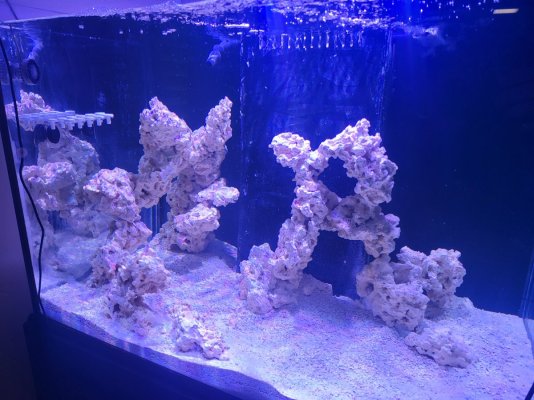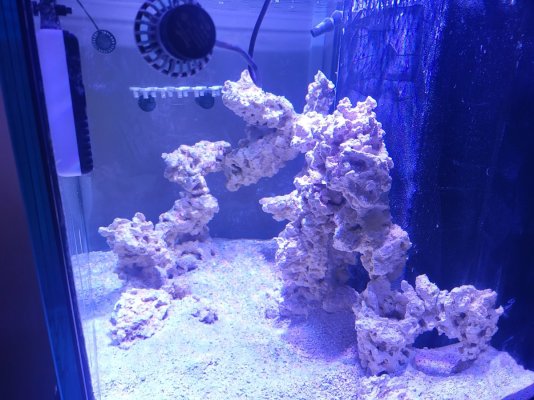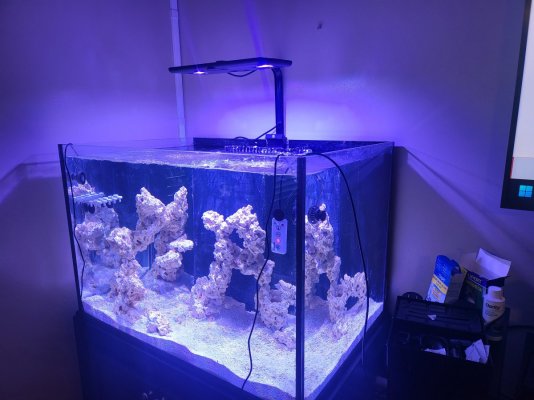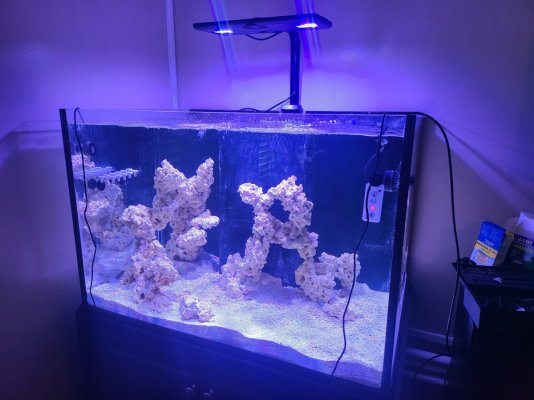Is the initial cycle done when you have low NH3 and high Nitrate readings? Using bacteria in a bottle with ammonia dosing?
Should I begin dosing kalkwasser immediately if PH and KH are lower than ideal?
At what point with a newly cycled tank should I start up my sulphur reactor?
I have been out of the hobby for 2+ years due to a move, but I'm getting back in. I want to take a technological\gear driven approach to this new 90 gallon build, with automated KH testing and dosing (kalkwasser), sulfur reactor, and automation using the Hydros controller.
I ultimately want this to be a packed flowy stony tank. My immediate concern is getting through the initial cycle.
I'm cycling my tank with Brightwell Aquatics Microbacter XLM. I bought the kit with their ammonia, XLM and Microbacter Clean. Dosed the tank with ammonia to 2 PPM, that was a week ago. I had a big bacterial bloom, super cloudy water, but that cleared up around day 4. Right now the water is crystal clear and just calling my name to add livestock.
I'm using the Seneye Reef monitor. I bought it mostly for the PAR meter, but I actually really like it, I may spend the $12.50 a month for new PH and NH3 cards. Hydros will give me PH readings but having two sources of data is attractive.
Seneye is telling me I have 3 hundreths (0.03) of a PPM NH3 and it's holding steady at that level for several days now.
On the other hand, my salifert ammonia test is reading between 0.5 and 1 PPM, and the LFS's red sea test read about 1 PPM. To my understanding, this is normal since those tests raise the PH to the point that NH4 is converted to NH3, they are reading 'total' ammonia, not just the toxic NH3, while the Seneye only reads NH3. My Hanna Checker nitrate is reading 69.8 PPM nitrate (which actually seems a bit high to me, I am going to retest).
So I believe right now that I'm cycled, and I should add my first livestock (after about a 50% water change) so I have a source of ammonia to keep the bacteria alive. Is my understanding correct?
Knowing myself, this is going to be a heavy stocked tank. I just love the look of a tank crowded with life and big tangs are my favorite fish. So I'm also planning on running a sulfur reactor to handle nitrates. Should I try to start it up right away? Or wait until I have a heavier bio load? I am going to add fish slowly over ~6 months.
My PH is reading low at 7.8 according to the Seneye. I'm having trouble with my Hydros X10, getting it to recognize the PH probe. And until I have the PH probe working I can't run KH tests with the Hydros iV. But, once I get that sorted out, assuming my PH is still low and KH is low, should I start dosing Kalkwasser immediately, or should I wait ~6 months when i plan to start introducing LPS?
I know this is a bit of a rambling first post, thanks in advance for your excellent experience, help and advice.




Should I begin dosing kalkwasser immediately if PH and KH are lower than ideal?
At what point with a newly cycled tank should I start up my sulphur reactor?
I have been out of the hobby for 2+ years due to a move, but I'm getting back in. I want to take a technological\gear driven approach to this new 90 gallon build, with automated KH testing and dosing (kalkwasser), sulfur reactor, and automation using the Hydros controller.
I ultimately want this to be a packed flowy stony tank. My immediate concern is getting through the initial cycle.
I'm cycling my tank with Brightwell Aquatics Microbacter XLM. I bought the kit with their ammonia, XLM and Microbacter Clean. Dosed the tank with ammonia to 2 PPM, that was a week ago. I had a big bacterial bloom, super cloudy water, but that cleared up around day 4. Right now the water is crystal clear and just calling my name to add livestock.
I'm using the Seneye Reef monitor. I bought it mostly for the PAR meter, but I actually really like it, I may spend the $12.50 a month for new PH and NH3 cards. Hydros will give me PH readings but having two sources of data is attractive.
Seneye is telling me I have 3 hundreths (0.03) of a PPM NH3 and it's holding steady at that level for several days now.
On the other hand, my salifert ammonia test is reading between 0.5 and 1 PPM, and the LFS's red sea test read about 1 PPM. To my understanding, this is normal since those tests raise the PH to the point that NH4 is converted to NH3, they are reading 'total' ammonia, not just the toxic NH3, while the Seneye only reads NH3. My Hanna Checker nitrate is reading 69.8 PPM nitrate (which actually seems a bit high to me, I am going to retest).
So I believe right now that I'm cycled, and I should add my first livestock (after about a 50% water change) so I have a source of ammonia to keep the bacteria alive. Is my understanding correct?
Knowing myself, this is going to be a heavy stocked tank. I just love the look of a tank crowded with life and big tangs are my favorite fish. So I'm also planning on running a sulfur reactor to handle nitrates. Should I try to start it up right away? Or wait until I have a heavier bio load? I am going to add fish slowly over ~6 months.
My PH is reading low at 7.8 according to the Seneye. I'm having trouble with my Hydros X10, getting it to recognize the PH probe. And until I have the PH probe working I can't run KH tests with the Hydros iV. But, once I get that sorted out, assuming my PH is still low and KH is low, should I start dosing Kalkwasser immediately, or should I wait ~6 months when i plan to start introducing LPS?
I know this is a bit of a rambling first post, thanks in advance for your excellent experience, help and advice.






















